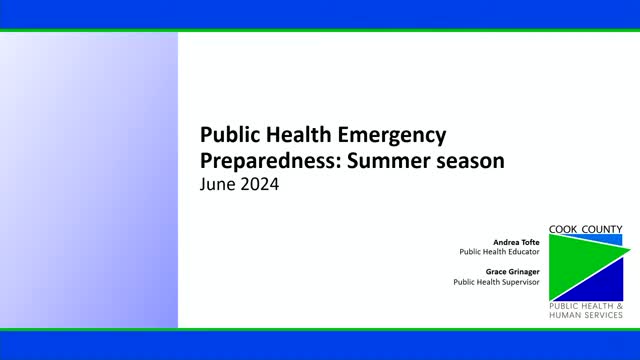Communities unite to tackle wildfire preparedness challenges
June 19, 2024 | Cook County, Minnesota

This article was created by AI summarizing key points discussed. AI makes mistakes, so for full details and context, please refer to the video of the full meeting. Please report any errors so we can fix them. Report an error »

In a recent government meeting, officials emphasized the importance of preparing for extreme weather events, particularly wildfires, as part of their public health emergency preparedness strategy. The discussions highlighted the dual focus on emergency preparedness and infectious disease control, with a specific mention of tick-borne diseases.
Andrea, the public health emergency preparedness coordinator, outlined the proactive measures being taken to address wildfire risks in Cook County. She noted that wildfires have been identified as a significant natural hazard in the area, especially following a report from the USDA that labeled the Superior National Forest as the most wildfire-prone forest in the eastern United States. This designation was attributed to reduced snowfall during the previous winter, raising concerns among residents and local agencies.
In response to these concerns, community leaders, including Commissioner Sullivan and representatives from Cook County Firewise and Minnesota Extension, have organized educational sessions aimed at enhancing community preparedness for the upcoming wildfire season. These initiatives have been well-received, with many residents expressing a strong desire to learn how to mitigate risks associated with wildfires.
Fortunately, recent rainfall has alleviated some immediate wildfire threats, but officials remain committed to ensuring that preparedness remains a priority. The meeting underscored the necessity of ongoing collaboration between public health and emergency management agencies to effectively address both environmental hazards and health risks in the community.
Andrea, the public health emergency preparedness coordinator, outlined the proactive measures being taken to address wildfire risks in Cook County. She noted that wildfires have been identified as a significant natural hazard in the area, especially following a report from the USDA that labeled the Superior National Forest as the most wildfire-prone forest in the eastern United States. This designation was attributed to reduced snowfall during the previous winter, raising concerns among residents and local agencies.
In response to these concerns, community leaders, including Commissioner Sullivan and representatives from Cook County Firewise and Minnesota Extension, have organized educational sessions aimed at enhancing community preparedness for the upcoming wildfire season. These initiatives have been well-received, with many residents expressing a strong desire to learn how to mitigate risks associated with wildfires.
Fortunately, recent rainfall has alleviated some immediate wildfire threats, but officials remain committed to ensuring that preparedness remains a priority. The meeting underscored the necessity of ongoing collaboration between public health and emergency management agencies to effectively address both environmental hazards and health risks in the community.
View full meeting
This article is based on a recent meeting—watch the full video and explore the complete transcript for deeper insights into the discussion.
View full meeting
